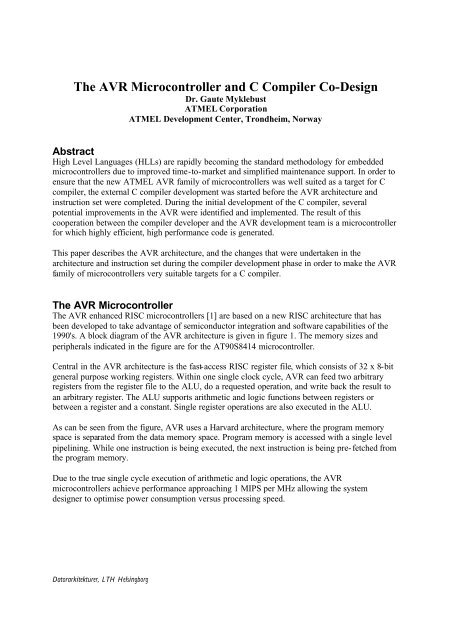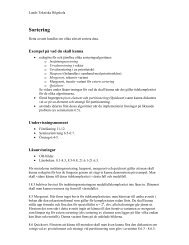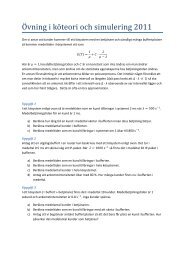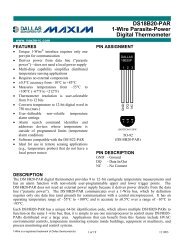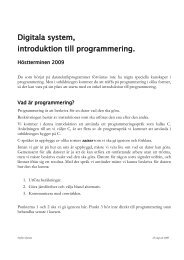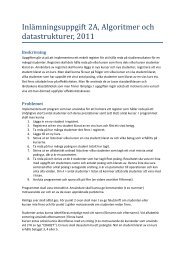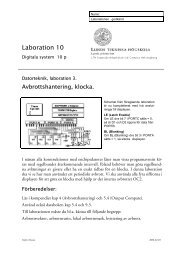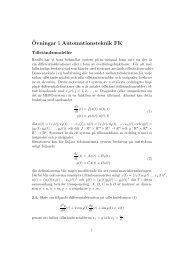The AVR Microcontroller and C Compiler Co-Design
The AVR Microcontroller and C Compiler Co-Design
The AVR Microcontroller and C Compiler Co-Design
You also want an ePaper? Increase the reach of your titles
YUMPU automatically turns print PDFs into web optimized ePapers that Google loves.
<strong>The</strong> <strong>AVR</strong> <strong>Microcontroller</strong> <strong>and</strong> C <strong><strong>Co</strong>mpiler</strong> <strong>Co</strong>-<strong>Design</strong>Dr. Gaute MyklebustATMEL <strong>Co</strong>rporationATMEL Development Center, Trondheim, NorwayAbstractHigh Level Languages (HLLs) are rapidly becoming the st<strong>and</strong>ard methodology for embeddedmicrocontrollers due to improved time-to-market <strong>and</strong> simplified maintenance support. In order toensure that the new ATMEL <strong>AVR</strong> family of microcontrollers was well suited as a target for Ccompiler, the external C compiler development was started before the <strong>AVR</strong> architecture <strong>and</strong>instruction set were completed. During the initial development of the C compiler, severalpotential improvements in the <strong>AVR</strong> were identified <strong>and</strong> implemented. <strong>The</strong> result of thiscooperation between the compiler developer <strong>and</strong> the <strong>AVR</strong> development team is a microcontrollerfor which highly efficient, high performance code is generated.This paper describes the <strong>AVR</strong> architecture, <strong>and</strong> the changes that were undertaken in thearchitecture <strong>and</strong> instruction set during the compiler development phase in order to make the <strong>AVR</strong>family of microcontrollers very suitable targets for a C compiler.<strong>The</strong> <strong>AVR</strong> <strong>Microcontroller</strong><strong>The</strong> <strong>AVR</strong> enhanced RISC microcontrollers [1] are based on a new RISC architecture that hasbeen developed to take advantage of semiconductor integration <strong>and</strong> software capabilities of the1990's. A block diagram of the <strong>AVR</strong> architecture is given in figure 1. <strong>The</strong> memory sizes <strong>and</strong>peripherals indicated in the figure are for the AT90S8414 microcontroller.Central in the <strong>AVR</strong> architecture is the fast-access RISC register file, which consists of 32 x 8-bitgeneral purpose working registers. Within one single clock cycle, <strong>AVR</strong> can feed two arbitraryregisters from the register file to the ALU, do a requested operation, <strong>and</strong> write back the result toan arbitrary register. <strong>The</strong> ALU supports arithmetic <strong>and</strong> logic functions between registers orbetween a register <strong>and</strong> a constant. Single register operations are also executed in the ALU.As can be seen from the figure, <strong>AVR</strong> uses a Harvard architecture, where the program memoryspace is separated from the data memory space. Program memory is accessed with a single levelpipelining. While one instruction is being executed, the next instruction is being pre-fetched fromthe program memory.Due to the true single cycle execution of arithmetic <strong>and</strong> logic operations, the <strong>AVR</strong>microcontrollers achieve performance approaching 1 MIPS per MHz allowing the systemdesigner to optimise power consumption versus processing speed.Datorarkitekturer, LTH Helsingborg
Figure 1: <strong>The</strong> <strong>AVR</strong> Architecture (ATmega32)<strong>The</strong> Architecture allows for up to 8M Bytes program memory, <strong>and</strong> 16MBytes of Data memory,<strong>and</strong> covers a wide range of applications.Fine tuning <strong>AVR</strong><strong>The</strong>re are several advantages in using HLLs instead of using Assembly language whendeveloping microcontroller applications. <strong>The</strong>re has, however, traditionally been one majordisadvantage: the size of the code increases. <strong>The</strong> <strong>AVR</strong> microcontroller was developed with the Clanguage in mind in order to make it possible to construct a code efficient C compiler for <strong>AVR</strong>.To improve this feature even more, the development of the C compiler was started before theDatorarkitekturer, Stefan Nyman 2
architecture <strong>and</strong> the instruction set were completed. By allowing professional compilerdevelopers at IAR Systems in Sweden to comment on the architecture <strong>and</strong> instruction set, wewere able to make a microcontroller very well suited for C compiler generated code.This section describes the modifications that were done in order to tune the architecture <strong>and</strong>instruction set towards even more towards the C language.Addressing modesIn order for the compiler to generate efficient code, it is important that the supplied addressingmodes matches the needs of the C language. <strong>The</strong> <strong>AVR</strong> architecture was originally equipped withtwo pointer registers. <strong>The</strong>se two pointers could be used for indirect addressing, indirectaddressing with post increment, indirect addressing with pre decrement, <strong>and</strong> indirect addressingwith displacement, giving good support for operations on pointers. In addition, there was a pageddirect addressing mode for accessing variables placed in the data memory.Displacements<strong>The</strong> indirect addressing mode with displacement is a very useful addressing mode, also from a Ccompilers point of view. For example, by setting the pointer to the first element in a struct,you can reach as far in the struct as the displacement allows you, without having to changethe 16-bit pointer. <strong>The</strong> indirect addressing with displacement mode is also frequently used foraccessing variables placed on the software stack. Function parameters, <strong>and</strong> autos are often placedon the software stack, <strong>and</strong> can be read <strong>and</strong> written without having to change the pointers. <strong>The</strong>displacement addressing is also very useful in addressing elements in an array.Even though the displacement mode is very useful in many cases, there was a problem with thereach of this addressing mode. Originally, the displacement was limited to 16 locations, whereasthe displacement needed in real applications often exceeds this number. In the case where thelocation can not be reached by the displacement mode, a new pointer needs to be loaded. Toexp<strong>and</strong> the reach of the displacement mode, we needed to change other parts of the instruction setto get enough coding space. At the same time, we were informed that the paged direct accessingmode was difficult to use from the compilers point of view. By removing the paged directaddressing mode, space was made available for exp<strong>and</strong>ing the displacement to 64 locations,which is large enough to meet most dem<strong>and</strong>s for indirect addressing. <strong>The</strong> paged direct addressingmode was changed to a two word unpaged direct addressing mode, see below.<strong>The</strong> number of memory pointers<strong>The</strong> <strong>AVR</strong> microcontrollers were originally equipped with two 16-bit memory pointers. From a C<strong><strong>Co</strong>mpiler</strong>s point of view, one of these pointers must be used as a ded icated software stack,leaving only one memory pointer for general usage. In many cases, you need to copy memoryfrom one area to another. Having only one memory pointer, you would need to read one byte, setthe pointer to the destination area, write the byte <strong>and</strong> then set the pointer back to the source dataarea. By including a third memory pointer (with reduced functionality), data can be copied fromone memory area to another memory area without having to set the pointers. By exploiting thepost increment mode of pointer addressing very efficient loops can be constructed for thispurpose (assuming Z points to first byte in source, X points to first byte in destination):Datorarkitekturer, Stefan Nyman 3
LDI R16,0x60 ; Load byte countloop: LD R17,Z+ ; Load byte, increment pointerST X+,R17 ; Store byte, increment pointerSUBI R16,1 ; Decrement counterBRNE loop ; Branch if more bytes<strong>The</strong> possibility to post-increment <strong>and</strong> pre-decrement also makes the pointers very efficient forimplementing stacks. This is of course utilized in the software run-time stack.Direct addressingAs described in the displacement section, we originally had a paged direct addressing modewhich was difficult <strong>and</strong> inefficient to use by the compiler. Since we needed coding space for anincreased displacement, the paged direct addressing mode was removed. It is, however,inefficient not having any direct addressing mode, since we in some cases need to accessvariables placed in the data memory area. Especially when dealing with static characters, thecode overhead will be large (50%), since static variables needed to reside in data memory<strong>and</strong> can not automatically be placed in registers. In order to overcome this problem withinefficient code, we decided to include unpaged direct addressing instructions taking a 16-bitaddress, making it possible to address 64KByte data memory in one instruction. In order toaccess such a large amount of memory, these instructions had to be two 16-bit words. Using thisaddressing mode is more efficient than using pointers when the number of bytes to be accessed issmall, for instance when a character is read. For larger areas, it may still be more effective to useindirect addressing (see example below).Loading of a character:Indirect addressing (6 Bytes):LDI R30,LOW(CHARVAR)LDI R31,HIGH(CHARVAR)LD R16, ZDirect addressing (4 Bytes):LDS R16,CHARVARLoading of a long integer:Indirect addressing (12 Bytes)LDI R30,LOW(LONGVAR)LDI R31,HIGH(LONGVAR)LDD R0,ZLDD R1,Z+1LDD R2,Z+2LDD R3,Z+3Direct addressing (16 Bytes)LDS R0,LONGVARLDS R1,LONGVAR+1LDS R2,LONGVAR+2LDS R3,LONGVAR+3Datorarkitekturer, Stefan Nyman 4
Zero flag propagationIn order to make conditional branches, a number of the instructions manipulates the <strong>AVR</strong> statusregister, which consists of a number of flags. A conditional branch instruction following such aninstruction, will branch or not branch, depending on the settings of these flags. <strong>The</strong> arithmeticinstructions manipulate the flags, making it possible to check whether a number A is smallerthan, equal to or greater than another number B. When the numbers in question are eight bitnumbers, there are no problems, since all the flags are depending on the flag setting done by oneinstruction only. When using 16 or 32 bit numbers, which is common in the C language, theproblem is somewhat more tricky, since a 32 bit subtraction, for instance, is calculated as 4consecutive 8 bit subtractions, <strong>and</strong> after each subtraction, a new set of flags is generated.For propagating the carry flag, most processors have incorporated instructions which takes intoaccount the previous setting of the carry flag, for instance SBC – subtract with carry where SBCA,B means A=A minus B minus Carry-bit. <strong>The</strong>re is however, another flag that needs to bepropagated in order to be able to correctly do all conditional branches. This is the Zero flag.Example:A=R3:R2:R1:R0, B=R7:R6:R5:R4We want to subtract B from A <strong>and</strong> jump to a specific location if A is equal to B. If the Zero flagis only dependent on the last arithmetic instruc tion, the following sequence will not do:SUB R0,R4SBC R1,R5SBC R2,R6SBC R3,R7 ;BREQ destinationR3=R7 => Zero flag setsince the flag settings present during the BREQ instruction only depends on the flags set by thelast SBC instruction. If the most significant bytes are equal, the Zero flag will be set <strong>and</strong> thebranch will be done, even if the 32 bit numbers are not equal. This problem also applies to otherconditional branches.<strong>The</strong>re are two ways of overcoming this problem. One is to save the flags produced by eachinstruction, <strong>and</strong> then check all the zero flags after the fourth subtraction is done. <strong>The</strong> other, moreelegant way, is to propagate the zero flag in the carry instructions like this:Znew =Not(R7) ANDNot(R6) AND...Not(R0) ANDZoldBy propagating the Zero flag in this way, all conditional branches can be done after thefinal subtraction, since all the rest of the interesting flags (overflow <strong>and</strong> positive flag)are only dependent on the most significant byte.Datorarkitekturer, Stefan Nyman 5
Tuning the arithmetic instructionsSome tuning of the arithmetic instructions was also done. This tuning is described here.Addition <strong>and</strong> subtractionWe originally planned to have both addition <strong>and</strong> subtraction with eight bit constants - ADDI <strong>and</strong>SUBI. We did, however, not have space for having Carry instructions with constants, so a 16 bitadd with a constant would look like this:ADDI R16,0x44LDI R18,0x55ADC R17,R18An addition can, however, be realized as a subtraction <strong>and</strong> vice versa, so it was decided that theADDI instruction should be changed to a SBCI instruction, thereby enabling 16 <strong>and</strong> 32 bitadditions <strong>and</strong> subtractions with constants, thereby reducing code size substantially in 16 <strong>and</strong> 32bit cases <strong>and</strong> with no code size penalty for 8 bit cases.<strong>Co</strong>mpare with constant<strong>The</strong> original instruction set did not include any instruction for comparing a register with aconstant. In order to do such an operation, a constant had to be loaded into a register, <strong>and</strong> then thetwo registers could be compared. This is a very frequently used operation, <strong>and</strong> as a result ofremoving one of the original addressing modes, space was found in the instruction coding for thisinstruction.Non-destructive comparisonIf you want to compare two eight bit numbers, then this can be done by using a compareinstruction. If you want to compare 16 or 32 bit numbers however, you would originally have touse subtraction with carry in order to get the flag setting right. <strong>The</strong> problem with usingsubtraction with carry is that it overwrites the contents of one of the numbers you are comparing.One solution to this problem is to copy this number over to new locations before subtracting, butsuch a solution will require more instructions <strong>and</strong> will use more registers. In order to overcomethis problem, we decided to include a <strong>Co</strong>mpare with carry instruction, thereby enabling nondestructive comparison of numbers larger than eight bit.<strong>Co</strong>nclusionsWe have constructed a microcontroller well suited for High Level Languages. <strong>The</strong> final tuning ofthe microcontroller done in cooperation with the C compiler developer, IAR Systems, has givenan additional improvement to the design. Evaluating the code generated from the compiler, itturns out that the modifications that were done after discussions with the compiler developerwere successful, as the generated code exploits the improvements frequently.References[1] ATMEL <strong>Co</strong>rporation. <strong>AVR</strong> Enhanced RISC <strong>Microcontroller</strong>s Data Book . May 1996.Datorarkitekturer, Stefan Nyman 6


